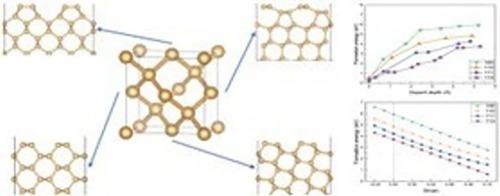应用拉伸应变在金刚石(113)表面有效掺杂磷:第一性原理计算
IF 5.1
3区 材料科学
Q2 MATERIALS SCIENCE, COATINGS & FILMS
引用次数: 0
摘要
磷(P)掺杂是金刚石中最可靠的n型掺杂,但P掺杂的低溶解度限制了其应用。为了解决这一缺点,通过第一性原理计算系统地研究了P掺杂在原始、氢化和氧化金刚石(100)、(110)、(111)和(113)表面的形成能值。结果表明,金刚石(113)表面的形成能小于金刚石(100)、金刚石(110)和金刚石(111)表面,表明其P掺杂效率最高。此外,拉伸应变显著降低了p掺杂金刚石表面的形成能,从而提高了掺杂效率。这些发现为实现p掺杂n型金刚石提供了新的方向,并有助于金刚石基半导体器件的设计。本文章由计算机程序翻译,如有差异,请以英文原文为准。

Efficient phosphorus doping on diamond (113) surface by applying tensile strain: first principles calculation
Phosphorus (P) doping is the most reliable n-type dopant in diamond, while the low solubility of P dopant limits its application. In order to solve this disadvantage, the formation energy values for P doping in pristine, hydrogenated and oxidized diamond (100), (110), (111) and (113) surfaces are systematically studied by first-principles calculation. The results show that the formation energy for diamond (113) surface is smaller than that of diamond (100), (110) and (111) surfaces, indicating its highest P doping efficiency. In addition, the tensile strain significantly reduces the formation energy of P-doped diamond surface, thus the doping efficiency improves. These findings provide new directions for the realization of P-doped n-type diamond and help in the design of diamond-based semiconductor devices.
求助全文
通过发布文献求助,成功后即可免费获取论文全文。
去求助
来源期刊

Diamond and Related Materials
工程技术-材料科学:综合
CiteScore
6.00
自引率
14.60%
发文量
702
审稿时长
2.1 months
期刊介绍:
DRM is a leading international journal that publishes new fundamental and applied research on all forms of diamond, the integration of diamond with other advanced materials and development of technologies exploiting diamond. The synthesis, characterization and processing of single crystal diamond, polycrystalline films, nanodiamond powders and heterostructures with other advanced materials are encouraged topics for technical and review articles. In addition to diamond, the journal publishes manuscripts on the synthesis, characterization and application of other related materials including diamond-like carbons, carbon nanotubes, graphene, and boron and carbon nitrides. Articles are sought on the chemical functionalization of diamond and related materials as well as their use in electrochemistry, energy storage and conversion, chemical and biological sensing, imaging, thermal management, photonic and quantum applications, electron emission and electronic devices.
The International Conference on Diamond and Carbon Materials has evolved into the largest and most well attended forum in the field of diamond, providing a forum to showcase the latest results in the science and technology of diamond and other carbon materials such as carbon nanotubes, graphene, and diamond-like carbon. Run annually in association with Diamond and Related Materials the conference provides junior and established researchers the opportunity to exchange the latest results ranging from fundamental physical and chemical concepts to applied research focusing on the next generation carbon-based devices.
 求助内容:
求助内容: 应助结果提醒方式:
应助结果提醒方式:


